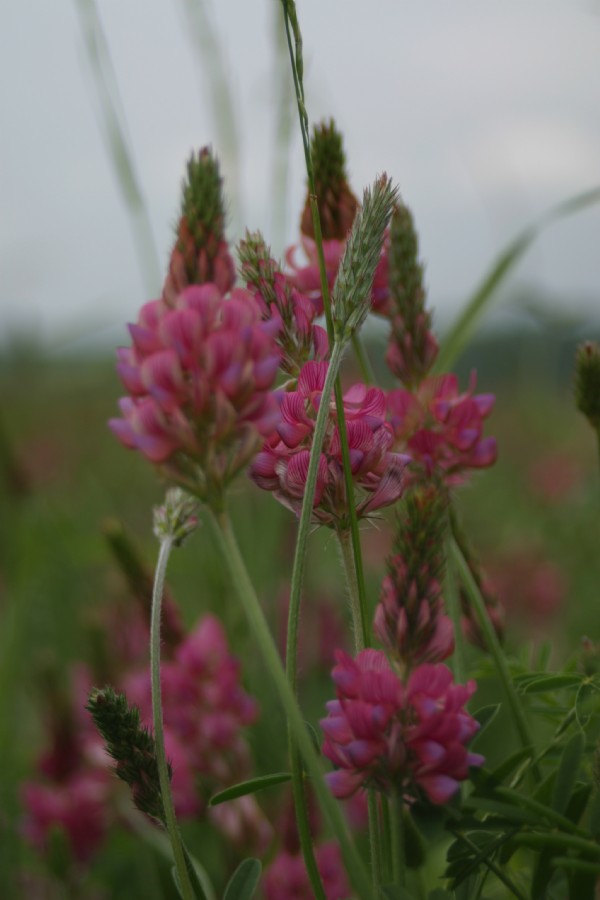

The main reason for promoting sainfoin is that it is a low input, non-bloating plant which fixes its own nitrogen and is suitable for both cutting and grazing. The following points summarize why sainfoin should be considered:
- High protein: The levels range up to 25% according to growth stage. The protein is largely undegradable in the rumen due to the presence of tannins. It has been shown that there is a much higher absorption rate than for lucerne.
- High voluntary intake: 20-40% greater than for grass on account of its very high palatability. It has lower fibre content than grass or other legumes with the exception of white clover. It is known that even when offered sainfoin straw from a second crop, animals will eat the material in spite of its unpromising appearance.
- It is ‘bloat-free’ due to being a tanniferous forage and is therefore good for grazing. This explains its popularity with sheep farmers in the past. At one time it occupied about 10% of the grassland area in Oxfordshire.
- Liveweight gains: Sainfoin has been shown to give the highest liveweight gains compared with other forages due to efficiency of protein uptake by the animal.
- Drought Resistant: It is drought resistant on account of a very deep root system, compared with lucerne. In Canada it is considered better than lucerne for light sandy soils.; it also improves the soil.
- Winter hardiness: this is also as good or even better than for lucerne. Therefore a ley can last for many years.
- Bees: Sainfoin has an extended period of flowering and is very attractive to bees. This can lead to high yields of honey; also it can provide a habitat for wild bees threatened with extinction. It must be considered a very environmentally-friendly plant.
- Micronutrients: It contains a high level of the major minerals (with the exception of sodium)
- Disease free: It is free from disease
- Medicinal: Finally, sainfoin was always renowned for its medicinal qualities. If you have sick animals or ‘bad doers’ they will quickly recover on sainfoin. I have heard this from several farmers brought up with the crop.
So with all these advantages why is sainfoin not more widely grown? Particularly on those soils which are suited to it, i.e. light alkaline soils with good drainage, also sandy soils and stony soils such as the Cotswolds brash.
The availability of cheap nitrogen led to the present unpopularity of legumes. It was quicker to establish a ryegrass sward, and improved varieties of perennials, especially, have been very successful from the fifties onwards. These grass leys fitted in with arable crops such as winter wheat and winter barley sown in the autumn. The opportunities for spring sowing and undersowing were few and far between.
In the present situation, with low prices in every sector, it may be right to go back to more extensive systems. Self-sufficiency in protein should be one of the objectives, and the larger legume crops are an alternative worth considering. Also there is a swing back to more spring crops.
Choosing which larger legume species to grow
1.Mainly for cutting:
Duration for 2-3 years only = red clover
Duration 4-5 years = lucerne
Both these will give very high yields when cut for silage, but are limited for grazing due to their bloating characteristic. It is only possible to graze safely either crop in autumn, but by this time the quality of the herbage is much reduced.
2.For cutting or grazing:
Duration 4-5 years= Sainfoin
Yields of silage will be lower but quality is better. Grazing is excellent and animal performance, especially for lambs and young stock will be greatly enhanced.
A Farmer's View
Hugh Pescod manages Broadwell Manor Farm near Lechlade, Gloucestershire for Mr Roger Goodenough. It is a demonstration farm for LEAF (Linking Environment and Farming). They have had sainfoin on this farm for many years. It fits in well with their sheep enterprise (300 breeding ewes) and they believe that the crop is beneficial to the soil with its deep rooting system. It also supports the LEAF philosophy, which is to use sensible methods of farming which are efficient but also benefit the environment.
Hugh has found sainfoin to be of most benefit to sheep rather than his dairy herd. He suggests a stocking rate of 3-4 ewes and lambs per acre when grazing. ‘The lambs do far and away better on it than grass. They put on more flesh more quickly’ he says.
He has decided to sow another 18 acres this spring. ‘It is too slow to get away in the autumn’ he says, so this time he is following a crop of autumn sown westerwold ryegrass. The ryegrass will be sprayed with ‘Roundup’ 10 days before cutting (mid-May approximately). This means he will be sowing the sainfoin when the ground has had time to warm up. The seed will be directly drilled into the sprayed stubble.
by Robin Hill of Cotswold Seeds, Forage Matters
Author: Robin Hill
Date Posted: 30th March 2017



